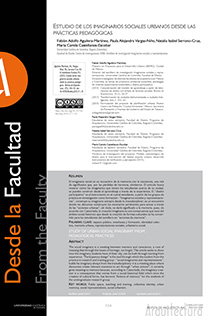
Revista de Arquitectura is an open access journal. More information...
Authors retain copyright and grant to the Revista de Arquitectura the right of first publication, which will be simultaneously subject to the Creative Commons (CC) BY-NC license.
Authors will sign a non-exclusive distribution license for the published version of the article by completing (RevArq FP03 Permission to Reproduce).
Self-archiving will comply with SHERPA/RoMEO guidelines and the Green classification.
To see in detail these guidelines, please consult...
Abstract
The social imaginary is a meeting between memory and conscience, a root of meaning that through the losses of heritage, we forget; This article seeks to show how the imaginary students have of their city, can be built through learning from experience. "Participatory design" is the tool through which the student from the practice in research and training group - "social imaginaries and representations", builds his imaginary always from the transdisciplinary; it is a meeting place where discourses create relevant scenarios to act through "urban actions"; it certainly gives meaning to memory because, according to Castoriadis, the imaginary creation is a consequence that comes from a social-historical field which since the creation of cultural forms, has become "Actions of memory" for the students of the undergraduate research group.

References
Aguilera Martínez, F. (2013). Transformación de ciudades deshumanizadas a ciudades inteligentes. ARKA Revista de Arquitectura, (3), 152-161.
Bargsted, M. (2013). El emprendimiento social desde una mirada psicosocial. Civilizar. Ciencias Sociales y Humanas, 13 (24), 121-132.
Bolaños Palacios, J. y Aguilera Martínez, F. (2014). Caracterización del modelo de aprendizaje a partir de laboratorios de diseño con énfasis en factores sociales. Revista de Arquitectura, 16, 26-37.
De la Torre Molina, C. (2008). Las identidades: una mirada desde la psicología. La Habana: Instituto Cubano de Investigación Cultural Juan Marinell.
Díaz, E. (1996). La ciencia y el imaginario social. Barcelona: Biblos.
Facultad de Arquitectura (2010). PEP arquitectura. Proyecto educativo del programa (3 ed.). Bogotá: Universidad Católica de Colombia.
Freire, J. (2010). Nómada, blog de juan freire. Sociedad y conocimiento abiertos. Recuperado de http://nomada.blogs.com/jfreire/2010/03/urbanismo-emergente-ciudad-tecnologa-e-innovacin-social.html
Hernández Ramírez, V. (2005). Reseña de "La memoria colectiva" de Maurice Halbwachs. Athenea Digital. Revista de Pensamiento e Investigación Social, 1 - 7.
Mefalopulos, P. y Kamlongera, C. (2008). Los principios para el diseño de una estrategia de comunicación. En FAO, Diseño participativo para una estrategia de comunicación (pp. 16-24). Roma: División de Comunicación de la FAO.
Steffens, K. (2013). Urbanismo táctico V3: casos latinoamericanos. Recuperado de http://www.ciudademergente.org/es/publicaciones/urbanismo-tactico-v3-casos-latinoamericanos/
Worchel, S., Cooper, J., Goethals, G. y Olson, J. (2002). Psicología social. Madrid: Paraninfo.
































